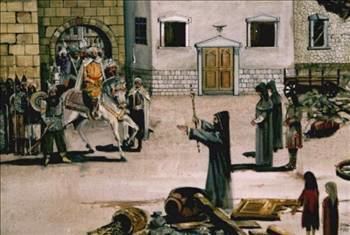Result Ottoman victory | Date 1511 | |
 | ||
Similar Ottoman–Mamluk War, Çınar incident, Battle of Otlukbeli, Battle of Chaldiran, Uprising in Banat | ||
Sahkulu rebellion 1511
The Şahkulu rebellion (9 April 1511 – 2 July 1511) was a widespread pro-Shia and pro-Safavid uprising in Anatolia, directed against the Ottoman Empire, in 1511. It began among the Turcoman tribes of the Taurus mountains, before spreading to a wide variety of disgruntled groups. It is named after the leader of the rebels, Şahkulu. His death in battle also meant the end of the uprising.
Contents
Background
The Safavid dynasty was consolidated and founded by Ismail I in the early 16th century. Ismail, being a champion of Shiite faith and partially a Turkmen, was also sympathetic to the Turkmens of Ottoman Empire. He sent agents to Ottoman lands (who usually used the unofficial title of khalif) to attract supporters. His activities did not escape the attention of the Ottomans, but the Ottoman Empire was too preoccupied with the oncoming period of interregnum during the last years of the crippled sultan Bayezid II. Thus Ismail was able to gain many supporters among Ottoman subjects. One such supporter was Karabıyıkoğlu, who adopted the title Şahkulu, meaning "servant of the shah". Ottoman sources however usually entitle him as Şeytankulu, meaning "servant of the Devil". He was living in the territory called Tekeli, named after the former beylik of Teke in a village near Antalya, southwestern Turkey. He was both a Shiite religious leader and a rebel leader.
Course of events
During the early days of interregnum, Korkut, one of the princes (Turkish: Şehzade), was travelling from Antalya to Manisa to be closer to capital. Şahkulu raided his caravan and robbed the treasury. Then he began attacking the towns and killing the government officers in the towns. He also raided Alaşehir to seize a part of royal treasure. Only then, an Ottoman force under Karagöz Ahmet Pasha, the beylerbey of Anadolu was sent to check his activities. But Şahkulu defeated the forces of Ahmet Pasha and executed him. This increased the fame and the prestige of Şahkulu. To his partisans, after raiding a royal caravan and killing a high-ranking Ottoman statesman, he was invincible. A second army was sent after him. The commanders of the army were Şehzade Ahmet, one of the claimants to throne, and the grand vizier Hadım Ali Pasha. They were able to corner Şahkulu near Altıntaş (in modern Kütahya Province), but instead of fighting, Ahmet tried to win over the Janissaries for his cause. Failing to achieve, he left the battlefield. Şahkulu saw his chance and escaped. Ali Pasha with a smaller force chased him, and clashed with him at Çubukova between Kayseri and Sivas. The battle was a draw, but both Ali Pasha and Şahkulu were killed (July 1511).
Aftermath
Şahkulu's partisans were not defeated, but they had lost their leader. Many scattered, but after a third army was sent by the Ottoman Porte, the most devoted escaped to Persia. During their escape they raided a caravan, and accidentally killed a well-known Persian scholar. Consequently, instead of showing them hospitality, Ismail executed them. Meanwhile, in Ottoman lands, Prince Ahmet's behavior in the battle caused reaction among the soldiers. Moreover the death of Hadım Ali, the chief partisan of Ahmet, provided an advantage to the youngest claimants to throne: the succession would ultimately fall to Selim I, under whose reign the Ottoman state saw spectacular victories and doubled in area. Selim was also a very devoted Sunni and effectively checked Shiite activities in Ottoman lands after defeating Ismail in the battle of Chaldiran in 1514.
